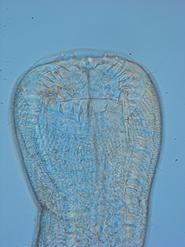
Visiting Assistant Professor of Biology Ashleigh Smythe spent 10 days in July working at the Smithsonian Institution’s National Museum of Natural History. She is currently describing a new species of nematode that she collected from sediment off the coast of Florida. Nematodes, commonly called roundworms, are found free living in most types of soil and sediment and as parasites in many animals.
The Smithsonian has one of the largest collections of nematodes in the world, and Smythe, a former Postdoctoral Fellow at the Museum, maintains her research appointment there and regularly uses the collection for reference in identifying nematodes.
The Smithsonian has one of the largest collections of nematodes in the world, and Smythe, a former Postdoctoral Fellow at the Museum, maintains her research appointment there and regularly uses the collection for reference in identifying nematodes.
Posted July 19, 2009
